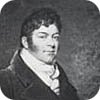|

|
William Madocks
William Alexander Madocks (June 17, 1773–September, 1828), was a landowner and Member of Parliament for the town of Boston, Lincolnshire from 1802 to 1820. He is best known, however, for his activities as an agricultural improver in north Wales, especially around the towns of Portmadoc and Tremadog, both of which he founded.
Madocks' family originally came from Denbighshire although Madocks himself was brought up in London. As the youngest son he was not wealthy, but he had great vision. His ambition was to open up this part of Wales and raise its prosperity by improving road and later rail links and by introducing manufacture. The Union with Ireland of 1800 meant through traffic was now likely. He promoted the building of turnpike roads; and to avoid the dangerous crossing of the Traeth Mawr (the estuary of River Glaslyn) or the long detour via Aberglaslyn bridge, he devised an ambitious scheme to build a great embankment across the Glaslyn estuary. This was to become part of a rail link across mid-Wales to Porth Dinllaen (now owned by the National Trust) on the Lleyn Peninsula which he hoped would become the main port for Dublin from London and the south of England. At that time the Menai Strait and the River Conwy were not bridged, but later his rivals succeeded in promoting the North Wales coast route and Holyhead became the principal port for Ireland.
In the autumn of 1811 the embankment (Cob) was finished. It had taken longer and cost more than anticipated, and Madocks’ creditors were pressing for payment. Now, an end to the financial worries seemed assured, with a toll from foot passengers and carriages, and the income from the reclaimed land. A four day feast and Eisteddfod was held to celebrate the Cob's completion.
Then in February 1812 high tides and a storm breached it. Madocks' agent and supporters held the creditors at bay, drummed up men and money from all around the county and finally repaired the breach and strengthened the whole embankment. By 1814 it was open again. But Madocks' finances were in ruins and all his properties were mortgaged. In 1821, he obtained an Act for a harbour at Ynys y Tywyn, to be renamed Port Madoc. By 1824, he was surveying the possible train routes from Porthmadog to the new slate quarries at Blaenau Ffestiniog. Within a generation, the harbour was busy, with slates from Blaenau Ffestiniog reaching the harbour via the Cob, carried by the Ffestiniog Railway. This commerce fuelled the growth of Porthmadog.
In 1826 Madocks and his family travelled to Italy for a holiday. Madocks wrote home frequently, sending instructions to John Williams for the preparation of their new house Morfa Lodge, (now Gelli Fair) above Porthmadog, for their return. But on the way home in 1828 Madocks died suddenly in Paris. He was buried on 17 September in the Père Lachaise cemetery, Paris. His daughter Eliza Anne (Maria) Ermine was only six, so his estate was held in trust until she came of age. His wife returned to her childhood home near Brecon leaving the estate to be split by those who had helped finance Madocks’ ventures. The memorial to this remarkable man is the little town of Tremadog, still near-perfect in its design and setting.
|

